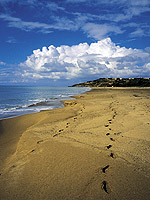
The Mouth of the Belice River - Castelvetrano
Sand, dunes that change position with the wind and amber colors typical of the desert characterise the Oriented Nature Reserve at the end of the Belice River.
This landscape quite rare in Sicily covers an area of 4 kilometers running between Marinella di Selinunte and Porto Palo promontory. The 241 hectares of the reserve are divided in 129 hectares of true reserve and 112 hectares of pre-reserve by a railway fallen into disuse. The inner area, where there are the dunes, is quite dry while the area near the river is more wet, with large temperature variations between day and night and sometimes subject to floods.
Administrative body
Provincia Regionale di Trapani
Via Vito Carrera, 23
Tel: 0923 873678
FLORA & FAUNA Flora – Strong and courageous – Resist the wind, salinity and high temperatures is not very easy for most common vegetation. The flora of the mouth of the Belice River is formed mainly by those herbaceous species that contribute to the preservation of the dunes. Those ones, in fact, are covered by the Bent grass, a perennial tall and thick grass important to avoid the dispersion of the sand because of the action of the wind. The Sea-lily and the Sea spurge also maintain the soil stable and promote the development of other species that need a more stable basis to grow. Because of its peculiarity other form of life can hardly survive in this area. This is the reason why there you can find only the species that learned to survive taking advantage of every little resource of the reserve. This is the case of the Psammophytes that evolved to save as much water as possible and reduce transpiration. Each time the wind covers them with sand, they can produce quickly new buds that reach the air. You can also find the Sea rocket, the Caltrop and the Prickly samphire. The area closer to the water is characterized by a typical vegetation of wet zones. There you can find the Reed grass, a grass with grey-violaceous flowers, the Sharp-Pointed Rush, the Bulrush, the Bog mint and the Equisetum. These species resist very well in areas subject to flooding. During the year, in fact, the sea floods the reserve. The rocky areas near the street and the disused railway line are characterized by the typical Mediterranean vegetation and especially by evergreen shrubbery like the Fan palm, the Euphorbia and the Oleaster. Fauna – Compulsory stopping place for migratory birds and turtles - Many species of birds choose the Mouth of the Belice River Reserve for breeding or resting during their migration. The Kentish plover is a coastal bird that prefers to nest in the sandy coastline while the Gallinule and the Fantail warbler prefer marshy areas. During migratory periods it is not unusual to see Herons, Anatids and other stilt-birds migrating. The disappearance of sandy landscapes and of the dunes from many areas of Sicily caused also the disappearance of a lot of invertebrates that lived there. The Mouth of the Belice River Reserve is the last refuge for a lot of insects that live in the dunes and for some Sicilian endemic species of beetles. This is the case, for example of the Ochrilidia sicula that formerly was widespread in Sicily and now lives only in a few beaches where there are bushes of Agropyron and Beach-grass. In the reserve you can also find the Brachytrypes megacephalus, whose burrow can be recognized by the heaps of sand at the entry. However the beautiful Caretta Caretta turtle is a true source of pride for the reserve. It always returns to spawn where it was born. The Caretta Caretta turtles live their life in the sea, even the mating, but when they have to spawn they reach the sandy coast and dug a hole to hide a large number of eggs that will open about two months after.
|

